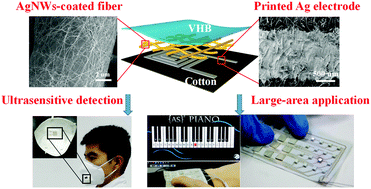Supersensitive all-fabric pressure sensors using printed textile electrode arrays for human motion monitoring and human–machine interaction†
Abstract
Integrating the advantages of ultrahigh sensitivity, good breathability, low-cost and large-area fabrication processes, and facile integration with other functional devices is full of challenges for wearable pressure sensors. Here, a novel all-fabric piezoresistive pressure sensor is designed with a bottom interdigitated textile electrode screen-printed using silver paste and a top bridge of AgNW-coated cotton fabric. The entire fabrication process is facile, economical and suitable for large-scale integrated production. Benefiting from the highly porous microstructure, large surface roughness and ultra-low resistance of the conductive fabric, our piezoresistive pressure sensors show excellent detection performance, including an extra-high sensitivity of 2.46 × 104 kPa−1 to 5.65 × 105 kPa−1 over a wide pressure regime (0–30 kPa), a giant on/off ratio of ≈106, a fast response time (6 ms), and a low detection limit (0.76 Pa). Thanks to these merits, the devices not only have the ability to detect various tiny signals of the human body, but also can be widely applied in a human–computer interactive system as a real wearable sensor platform, which was demonstrated by playing the piano and computer games.



 Please wait while we load your content...
Please wait while we load your content...